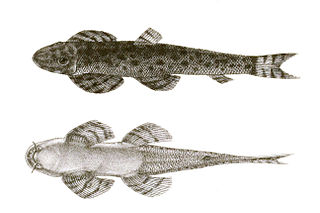
Cobitidae, also known as the True loaches, is a family of Old World freshwater fish. They occur throughout Eurasia and in Morocco, and inhabit riverine ecosystems. Today, most "loaches" are placed in other families. The family includes about 260 described species. New species are being described regularly.

Qiao Zong was a Han Chinese military leader in present-day Sichuan province in China during the Eastern Jin Dynasty. He proclaimed himself the Prince of Chengdu in 405 and was given the title "Prince of Shu" by Yao Xing, ruler of the Later Qin, in 409. His state is therefore sometimes known as Western Shu. His self-governing body coordinated offensive campaigns with Later Qin along the Yangtze River until Qiao's state was destroyed by a campaign under military subordinates of Liu Yu in 413.

Diapensiaceae is a small family of flowering plants, which includes 15 species in 6 genera. The genera include Berneuxia Decne., Diapensia L., Galax Sims, Pyxidanthera Michx., Shortia Torr. & A.Gray, and Schizocodon Siebold & Zucc.. Members of this family have little economic importance; however, some members are cultivated by florists.
Sinocyclocheilus is a genus of freshwater fish in the family Cyprinidae that is endemic to Guangxi, Guizhou and Yunnan in China. Almost all of its species live in or around caves and most of these have adaptions typical of cavefish such as a lack of scales, lack of pigmentation and reduced eyes. Several species have an unusual hunchbacked appearance and some of the cave-dwellers have a "horn" on the back, the function of which is unclear. In contrast, the Sinocyclocheilus species that live aboveground, as well as a few found underground, show no clear cavefish adaptions. They are relatively small fish reaching up to 23 cm (9.1 in) in length. The individual species have small ranges and populations, leading to the status of most of the evaluated species as threatened. Many species populations in the genus have yet to be evaluated by the IUCN.
Anabarilius is a genus of ray-finned fish in the family Cyprinidae, most of them only occurring in the area of China. Many of the species have very restricted geographic range and have been negatively impacted by introduced species, fishing, and habitat degradation; the IUCN Red List includes five Anabarilius species that are either endangered or critically endangered and one species that is considered extinct.

Cobitis is a genus of small freshwater fish in the family Cobitidae from temperate and subtropical Eurasia. It contains the "typical spiny loaches", including the well-known spined loach of Europe. Similar spiny loaches, occurring generally south of the range of Cobitis, are nowadays separated in Sabanejewia.
Oreonectes is a genus of fish in the family Nemacheilidae found in the rivers and caves of Asia. Many of these species are troglobitic.
Protocobitis is a genus of loaches endemic to Guangxi in China and living in caves.

Schistura is a genus of fish in the stone loach family Nemacheilidae native to the streams and rivers of the southern and eastern Asia. Some of these species are troglobitic.
Sinogastromyzon is a genus of hillstream loaches native to eastern Asia.

Yunnanilus is a genus of small stone loaches that are endemic to southeastern China, especially Guangxi and Yunnan. They are found in rivers, streams and lakes; some species are restricted to caves.

Beaufortia is a genus of gastromyzontid loaches from China and mainland Southeast Asia.
Yunnanilus macrolepis is a species of stone loach which is endemic to China. Its type locality is Luoping County in Yunnan. Some authorities consider Y. macrolepis to be a junior synonym of Yunnanilus paludosus.

Balitora is a genus of fish in the family Balitoridae endemic to Asia.

Loaches are fish of the superfamily Cobitoidea. They are freshwater, benthic (bottom-dwelling) fish found in rivers and creeks throughout Eurasia and northern Africa. Loaches are among the most diverse groups of fish; the 1249 known species of Cobitoidea comprise about 107 genera divided among 9 families.
Homatula is a genus of stone loaches endemic to China.

Jinshaia is a genus of hillstream loaches endemic to China.
Rectoris is a genus of cyprinid fish found in China and Vietnam.

The Nemacheilidae, or stone loaches, are a family of cypriniform fishes that inhabit stream environments, mostly in Eurasia, with one genus, Afronemacheilus found in Africa. The family includes about 790 species.

The Gastromyzontidae are a family of loaches native to China and Southeast Asia, where typically found in streams and rivers with a fast current. The family includes about 137 species in eighteen genera. This family was resurrected by M. Kottelat in his review and revision of the loaches in 2012. They are commonly called hillstream loaches.










